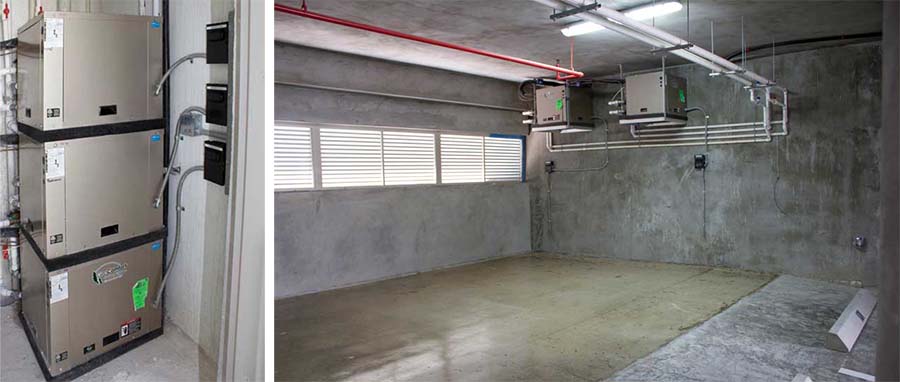Building decarbonization figures prominently in the effort to combat global warming, and buildings are increasingly adopting geothermal as a way to do that. Oklahoma uses geothermal energy to heat and cool its state capitol. Michigan’s state capitol is going the same way. So is St. Patrick’s Cathedral in New York City and Ball State University in Indiana.
“Commercial building stakeholders are showing interest in geothermal for a variety of reasons, like the environmentally friendly aspect, lower electrical power requirements for energy and cost savings, low lifecycle costs, federal tax credit incentives for an accelerated return on investment … and from an aesthetic standpoint, geothermal doesn’t require an outdoor unit or rooftop equipment,” said Steve Smith, CEO of Enertech Global. “As LEED certification and net zero building continues to become more mainstream, geothermal stands out as the perfect fit because it checks all the boxes for that type of building.”
RETURN ON INVESTMENT
The scope of geothermal projects continues to expand. While residential sales used to be Enertech Global’s primary business, commercial opportunities and large residential projects are showing an uptick in sales. The company is also seeing entire subdivisions and large developments committed to geothermal. The company is seeing the most commercial growth in military bases, hotels, apartment complexes, condos, and greenhouses — and demand comes from new markets all the time.
“We’ve experienced more commercial applications installing geothermal in warmer environments, like the Caribbean, because it’s the most efficient way to cool and the equipment isn’t exposed to the harsh, outdoor elements,” Smith said.
Growth remains tied to profitability. Bosch sees increased demand for the application of water source heat pumps in buildings because they yield a high return on investment for the building owners.
“Overall, developers have become more sustainably minded and interested in the eco-luxury market, but there’s a balance between being green and being profitable,” said Andrew Archambault, product manager of FHP and Commercial for Bosch Thermotechnology Corp. “Many will own a new building for five to seven years and then sell it and make a lot of money. If that’s the case, they often install the most inexpensive heating and cooling system.
“However, if you have developers who are more conscientious about the environment, they may select a more premium option, such as a water source heat pump product, because they know they can get more money for their building due to its advanced features and more modern design considerations.”
Specific growth segments vary by location, Archambault said.
“Overall, we are seeing more geothermal systems in small to mid-size office buildings, warehouse and storage facilities, and even condominiums or other similar housing units,” he said. “The sweet spot is really in low- to mid-rise buildings because that’s where you are going to see the highest return on your investment.”
The size of a building is what dictates the footprint of its geothermal loop, Archambault said, meaning it makes more sense for one of these buildings than a high-rise. But there are savings at any size.
“Geothermal and water source heat pumps are, hands down, the most efficient way to heat or cool a building,” Archambault said.

RESORT LIFE: Tides, a resort in the Grand Cayman Islands, incorporates geothermal for its HVAC needs. The equipment isn’t exposed to the harsh, outdoor elements.
TAX CREDITS LOWER UPFRONT COSTS
The biggest barrier to the technology is upfront cost. To offset this cost, the federal government offers a 10 percent investment tax credit for the entire cost of installation. The tax credit covers the additional cost of the loop that draws the heat out of the ground.
“Geothermal systems normally rise above conventional systems in regards to life-cycle costs and return on investment,” Smith said. “The tax credit accelerates this, making the decision to move to renewable technology an even easier choice.”
The initial tax credit for geothermal ended in 2016, even though credits for solar and other alternatives were extended. Doug Dougherty, CEO of the Geothermal Exchange Organization (GEO), said losing the credit severally hampered the industry. It was reinstated in 2018, but it will take several years to rebuild what was lost in 2017, Dougherty said.
The credit remains in place for the next two years, and there are bills in Congress to extend the credit five years beyond that. Dougherty expects one of those bills will move forward, along with a number of energy credit bills that will be combined into one bill before the end of the year.
An even larger credit would help, Dougherty said. If geothermal had a 30 percent tax credit for commercial buildings like solar and wind, there would be Wall Street financing for third-party investment, as there is for other alternatives.
THE FUTURE
The machines themselves haven’t come down in price, although they offer more value with new features such as fully variable compressors.
“The technological advances continue to amaze me, and I’ve been in the industry for 30 years,” Dougherty said.
One area of progress that could drive down costs is the drilling. Archambault said best practices from the oil and gas industry are migrating to geothermal installing, and there are several new companies entering the space. In the immediate future, Archambault sees 1 percent growth in the commercial market for geothermal.
Bosch has been seeing more demand from educational facilities, which helps develop demand among the next generation of consumers and decision-makers.
“We’ve facilitated projects at schools in several areas of the country — most recently, Texas — where the students are ambassadors for decreasing their school’s carbon footprint,” Archambault said. “Oftentimes, these schools are selecting water source heat pumps for their heating and ventilation to complement other sustainable technologies such as solar or wind power. That trend is partly because our educators are instilling the importance of green technologies in children at an early age. It’s refreshing to see young, future-minded individuals committed to serving as change-makers.”
See more articles from this issue here!



Report Abusive Comment